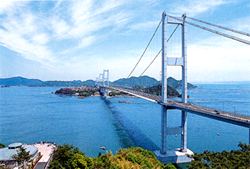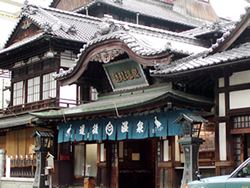Voice: +81-89-927-8530 (from 10AM to 4PM in JST on Mon-Fri)
If you are a citizen of one of the over 60 countries and regions, with which Japan has a "general visa exemption arrangement", you need only a valid passport to enter Japan as a "temporary visitor". Otherwise, you need to obtain a visa before entering Japan. To apply for a visa, please refer to the Ministry of Foreign Affairs of Japan website. Temporary visitors from most countries are allowed to stay for up to 90 days. All foreign tourists in Japan are required to carry their passports with them at all times.
If you need an invitation letter for your visa application, please contact to RCSCE secretary,
People coming to Matsuyama will probably first fly in to Tokyo Narita airport. There is no direct flight to Matsuyama airport from Narita airport but from Tokyo Haneda airport operated by Japan Airlines (JAL) and All Nippon Airways (ANA). Airport Limousine provides transportation between Narita and Haneda by bus (JPY 3,000, 75 minutes). If you fly in to Osaka Kansai airport first, there are direct ANA flights (two flights per day) to Matsuyama from Kansai airport. Frequent flights (JAL and ANA) from Osaka Itami airport to Matsuyama are also available. It takes 75 minutes from Kansai airport to Itami airport by bus (JPY 1,700). It is a 90-minute flight from Haneda airport and a 50-minute flight from Kansai or Itami airport. From Seoul and Shanghai, there are international flights to Matsuyama airport.
Also accessible by train from Narita airport or Kansai airport to JR Matsuyama station, it is a seanic route through beautiful Seto Inland Sea. From Narita it takes more than 8 hours by Narita Express (Narita airport to JR Tokyo station), Shinkansen (JR Tokyo to Okayama), and Limited Express Shiokaze (Okayama to JR Matsuyama station). It is a 5 hours trip from Kansai airport with Airport Express Haruka (Kansai airport to Shin-Osaka station), Shinkansen (Shin-Osaka to Okayama), and Limited Express Shiokaze (Okayama to JR Matsuyama station). Japan Rail Pass may be convenient for travellers by JR train (see Japan railways web for more information).

From Matsuyama airport, a bus takes passengers into Matsuyama city center. The bus stops first at JR Matsuyama Station (JPY 300, 15 minutes), then at Ehime Shinbunsha Mae (JPY 400, 17 minutes), at Matsuyama-shi Station (JPY 400, 20 minutes), at Ichiban-cho/Okaido (JPY 450, 25 minutes) and finally at Dogo Onsen (450 yen, 35 minutes). Your hotel may be located in JR Matsuyama station, Minami Horibata/Nishi Horibata, Ichiban-cho, or Dogo onsen areas, corresponding to the bus stops respectively (see also the accommodation page).
Tram is a convenient way to travel around the city. There are six tram lines. From JR Matsuyama station a tram bound for Dogo Onsen (Tram Line No. 5) takes you to Nishi Horibata, Okaido (Ichiban-cho), and Dogo Onsen. Each tram indicates its line number at the top of the front window. A sigle trip costs JPY 150.
You also easily find a taxi at the airport and JR station, and on main streets in the city.
Ehime university has several campuses in Matsuyama city. Among them, Johoku campus is the main, largest campus. COSMOS team meeting 2009 will be held at Media Hall, Center for Information Technology in Johoku campus. Research Center for Space and Cosmic Evolution (RCSCE) is also located in Johoku campus. From the hotel areas, it takes 5-15 minutes to Johoku campus by taxi or tram. Here are address cards for your and taxi driver's convenience.
By tram the nearest station to Johoku campus is Sekijuji Byoin Mae (Matsuyama Red-cross Hospital) in a 5-minutes walk to Johoku campus. A No. 1 line tram takes you to Sekijuji Byoin Mae from JR Matsuyama station or from Nishi Horibata. It takes 15 mitutes and 18 minutes, respectively. From Okaido (Ichiban-cho) it takes 7 minutes by No. 2 tram to Sekijuji Byoin Mae. From Dogo Onsen first get a tram (line No. 3, 5 or 6) to Kami-ichiman station (5 minutes). Change there to a No. 2 tram at the opposite platform and you will arrive at Sekijuji Byoin Mae in 2 minutes. You can ask the driver for a transfer ticket ("Norikae Ken" in Japanese) with paying the fare when you get off the first tram at Kami-ichiman and use it for the second tram.
The island of Shikoku is the smallest of the four major islands of Japan, with an area of about 20,000 square kilometers. It has a mild temperature ranging from 5°C to 27°C and faces the Pacific Ocean to the south and the Seto Inland Sea to the north. Three extensive bridge systems link Shikoku to the main island of Honshu.
Ehime Prefecture, with a population of about 1,500,000, is the largest of the four prefectures on Shikoku. It is bordered on the north and west by the Seto Inland Sea National Park with hundreds of small islands covered by green pine trees. The prefecture is protected from typhoons and extremes of hot weather by the Shikoku Mountain Range in the south. The latter contains the sacred mountain, Ishizuchi-san, 1,982 meters high, which is the highest mountain in western Japan. Shikoku is also noted for the 1,300 km pilgrimage of 88 sacred temples related to the great Buddhist priest and scholar, Kobo-Daishi.


Matsuyama is the largest city on Shikoku, the capital of Ehime Prefecture and the home of Ehime University. It has an international airport which is connected to Osaka and Tokyo by about 30 flights a day. The city can also be easily reached by train, bus, ferry or hydrofoil. With a population of half a million, it is a calm, regional center with a famous hot spa. In the center of the city sits Matsuyama Castle 132 meters above sea level. Dogo Hotspring Spa, located in the northeast corner of the city, has a history of over 3,000 years; it is said to be the oldest hot spring spa in Japan. Matsuyama is also one of the few cities left in Japan to have streetcars.
Matsuyama is noted for its rich cultural background; haiku poetry is probably the most famous cultural element and Masaoka Shiki, who was born here in 1867, started the modern haiku movement at the turn of the 20th century. In 1994, Kenzaburo Oe, who was born and raised near Matsuyama, was awarded the Nobel Prize in Literature. Tobe, a village famous for porcelain production, lies just south of the city. Bamboo products and cotton ikat cloth are two other traditional crafts of this area. There are many local festivals throughout the year.
Two large, covered shopping arcades (Okaido and Gintengai) run through the city center just south of the castle. While the city is certainly not as cosmopolitan as Tokyo or Osaka, the variety and quality of international food and restaurants are increasing.
For more information on Matsuyama, please check the linked websites following.